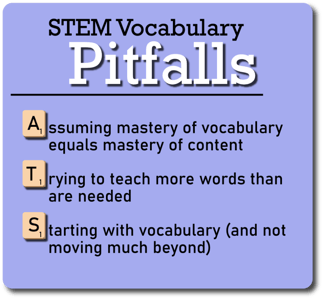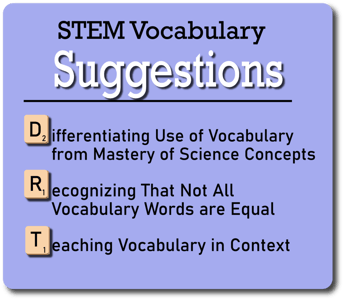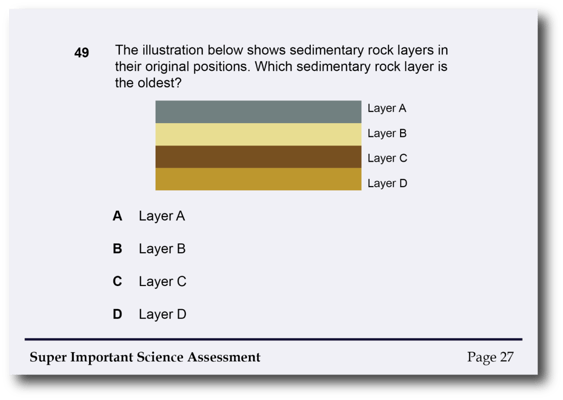
5 Easy Math Engagement Strategies for the Classroom
The news headlines are daunting. Math scores are down. School districts are scrambling to turn things around. And...
CJ Thompson | Published March 04, 2024
I love words. More generally, I love language.
In college, I took a year of Tagalog, a language I had never heard of, simply out of interest, and seriously considered majoring in linguistics.
I love learning about different languages and how they work. More specifically, I love the rich and varied vocabulary of English and, even more specifically, the words we use in science.
I preface this article with my profession of deep and abiding affection for science vocabulary because often when I express my reservations about how we approach science vocabulary in the classroom, people believe that I am anti-vocabulary. Nothing could be further from the truth.
My critique is not based on animosity but rather my acknowledgment of the importance and power of language, especially in the science classroom, and my conviction that a thoughtful approach to vocabulary learning is essential.

Setting aside, for the moment, content-specific words, effective communication, is a critical competency in STEM. Any list of STEM skills is bound to include communication.
It is, along with critical thinking, collaboration, and creativity, one of the four Cs of STEM fluency. Indeed, one aspect of effective communication in science is the ability to use science vocabulary accurately and effectively.
It is reasonable for teachers to look at the way students understand and use words as part of a broader effort to evaluate students' proficiency in the underlying key concepts of any unit of study.
For example, students learning about integers might be expected to accurately describe the difference between positive and negative and to apply the terms correctly as a demonstration of their understanding.
Even students in the classroom of a teacher who employs more diverse assessment strategies, including hands-on application of skills and concepts and non-verbal displays of proficiency, are ultimately responsible for demonstrating their science learning on a standardized test at the end of the year, a test that, for the most part, relies heavily on verbal communication, including scientific terms.
While acknowledging how important vocabulary is in science teaching, I believe, based on my years in science and math classrooms, that there are some common mistakes teachers often make.
I've made these mistakes myself and seen others struggle with them as well. I will expand on each more fully, but here's my list of common science vocabulary pitfalls.

These are not the only or even the most serious pitfalls. If you are a classroom teacher, you can probably think of a couple yourself.
This list represents the issues I have observed in my classroom and the classrooms of other teachers that lead to poor outcomes for students and major frustration for those of us trying to support their STEM learning.
What follows are my suggested strategies for addressing each of these pitfalls. Here, I share stories from my career in STEM education.
I use these anecdotes because my list of pitfalls and my proposed remedies are based on my experience during more than three decades in mostly science classrooms.
As stated above, I believe that one way to determine students’ understanding of key concepts is to evaluate how they communicate about them, and this certainly includes the correct use of the associated terms.
Here, I’m simply arguing the following:
The first of these propositions is particularly relevant when applied to many of the basic skills of STEM.
Take, for example, measurement. A student can master the skill of using a triple-beam balance to find the mass of an object while being unable to correctly describe how to do it.
Indeed, the student may not even know the name of the tool they are using or any of its parts. There's nothing wrong with asking students to know terms like linear, scale, and dimensions.
One should keep in mind, however, that it's possible for a student who can't use these terms to be able to use a ruler to accurately measure something.
I'm not arguing that one skill is more important than the other, just that they are distinct.
Most of my experience as a teacher was with ESL (English as a Second Language) students. Although these students struggled with the language, many of them demonstrated a high level of proficiency in many of the skills we associate with STEM.
They could "do" science or math, but if we only looked at how they could "speak" or "write" science or math, we might not get a complete and accurate picture of their abilities.
As STEM teachers, we need to support language development in students, particularly their STEM communication. We should, however, remember that language is not the only way to know what students know and what they can do.
This leads me to my second proposition and the error of failing to examine students' mastery of concepts beyond a superficial linguistic performance.
I witnessed a dramatic display of this when visiting the science classroom of a teacher I was mentoring. The students were engaged in a classic earth science laboratory investigation. They allowed water to flow over a pile of sand at the higher end of a rectangular tub, observing how the water carried the material to the lower end of the tray, where it collected.
As the teacher walked the room monitoring students, I followed close behind. At one point, she asked a student, "What's going on here? What do you observe?" The student quickly responded, "Erosion and deposition."
Satisfied, the teacher moved on to the next table, but I paused to ask the young man what he meant by his answer. He responded with a shrug and an expression that said, "I have no idea."
Is it possible that the student I spoke to understood the concepts of erosion and deposition and could have made the connection between these terms and his observations and maybe even their representation in real-world geology?
Maybe, maybe not.
My point is that, without deeper questioning, we don't know. Classroom time is limited, and teachers are under enormous pressure to assess many students over a lot of content as quickly as possible.
It is tempting to use a simple verbal display such as the one described above as evidence of mastery. However, I am proposing that we demand more of our students.
If we want students to be able to effectively communicate their understanding of STEM concepts, they’re going to need the right words.
And we can’t ignore the fact that they will encounter some specific vocabulary when they take standardized assessments.
Still, we have only so much time, and students have varying, but ultimately limited, capacity for learning material. How do we narrow the word list to something manageable but also sufficient to ensure student success?
I suggest two sources to help in the selection process: standards and assessments.
The connection between standards, assessments, and teaching is well-established, from the curriculum-instruction-assessment triad (Achtenhagen, 2012) to Wiggins & McTighe's Understanding by Design (2005).
Most classroom teachers are bound by a set of learning objectives set by their school district, which, in turn, are determined by their state's Department of Education.
It only makes sense to use these standards as a guideline for what to teach since, ideally, the assessment students must pass is tightly aligned with these standards.
I say "ideally" because the test writers have their own approach to and interpretation of standards, and frequently, it does not agree with our own or that of those in charge of what is taught.
For this reason, careful attention must be paid to each individually.
When we're lucky, standards are explicit about the vocabulary for which students are responsible.
For example, if a standard requires students to "classify materials as either conductors or insulators of electricity," it makes sense to ensure that students understand and can use the science terms in that standard.
I would suggest, however, that we be cautious about following the verbiage of the standards too strictly.
Imagine a Kindergarten standard that asks students to "distinguish between the three common states of matter."
Most of us would agree that the students don't need to know the word "distinguish," and we could debate whether "states of matter" are appropriate for kids this age, even though these terms appear in the standard.
On the other hand, most would agree that the kids should know the three words that are not in the standard, namely solid, liquid, and gas.
As tricky as standards might be for determining the appropriate vocabulary, assessments are even trickier. We have a relatively small number of standards that are mostly constant from year to year.
On the other hand, teachers and their students face a daunting number of assessments with a wide variety of terms that constantly change.
Teachers can control the tests they construct themselves, but they are at the mercy of external entities when it comes to other assessments.
I can offer no specific guidance for all the assessments teachers have to deal with, but I can describe a method I used and the insights I gained.
Several years ago, when I worked as part of a professional development project, I partnered with a classroom teacher to analyze the vocabulary of our state elementary science test.
We had six versions that had been previously released and set about making a tally of all the words. We excluded prepositions, definite and indefinite articles, helping verbs, etc., and focused on the words that were essential to understanding the question.
We learned a couple of interesting things.
First, some of the content-specific vocabulary we expected to see was missing, replaced by more ordinary words. In the six tests we looked at, with 300 items, the word "beaker" appeared precisely zero times, while "container" appeared several times.
Second, the most common word, the word that topped the list in frequency, occurring in around 67% of all the test items was… water.
My takeaway from this and my message to teachers who worried obsessively about vocabulary was simple. Do your students know the word water? Then they're already doing pretty good.
Of course, this analysis was done in Texas more than a dozen years ago for one version of a science assessment. I’m not suggesting that the specific insights gained are applicable more generally.
What I am suggesting is that if we want to ensure that students are prepared for an assessment, we need to go beyond what we assume will be on the test and make a careful investigation.
I’ll add one further caution, and that’s to avoid thinking that all the words from previous tests, even the words that cause issues, need to be taught. I call this the cantaloupe fallacy, and here’s why.
Several years ago, I was working closely with fifth-grade teachers whose students had to take the state science assessment. Every spring, after the test, some of the more challenging items became a popular topic of discussion.
One year, it seemed that everyone was talking about the cantaloupe question.
The item involved a model of the solar system using everyday objects to represent the planets and their relative sizes.
The problem was that one of the options was cantaloupe, a word many students had never seen before. More than one teacher I spoke with considered adding cantaloupe to the list of words they planned to teach.
The problem with this is obvious. First, the word is unlikely to appear on the state test again.
Second, if we add every unique and challenging word on the tests, our vocabulary list will soon be full of obscure terms that are unlikely to be helpful in future assessments.
My final suggestion might be the most controversial and is the one that inspires the most pushback from teachers and that's the idea that we should stop trying to frontload vocabulary.
The idea that students need to learn words before encountering a phenomenon is so popular that, in some classrooms, it's embedded in the lesson structure.
I've worked with teachers who begin every unit by sharing a list of vocabulary words, insisting that students write them out along with their definitions, perhaps making vocabulary flashcards and drilling with them, all of this before any exposure to the concept being studied.
I’m not opposed, per se, to having students write out words and definitions or drill with flash cards.
What I am promoting is the idea that students are better served if they are exposed to a phenomenon before, or maybe I should say, simultaneously with the introduction of any new vocabulary.
By presenting students with a novel phenomenon, we create the need for new words to talk about it. This seems to me a more logical approach and one that reflects how language works.
When humans encounter something new, they need language to describe it, and only then create the new words to meet this need.
I’ll point out that the idea that students, and all humans, learn vocabulary in context through hands-on activities is not only intuitive and logical, but it’s supported by research (Lloyd & Contreras, 1985; Sternberg, 2014).
Teaching vocabulary in context is something I not only preach; it's something I practice.
I used to raise mealworms in my classroom. When it came time to learn about life cycles, I could provide all the students with live examples of adult Tenebrio (darkling) beetles, larvae, and pupae. The kids loved it!
For many, it was the first time they had seen different stages of metamorphosis all together. As students excitedly talked about what they saw, they were primed to learn the target vocabulary.
As we talked, I could point out that the "black bug" crawling around is an "adult," the "worm" is a larva, and the "weird thing that looks like an alien" is called a "pupa."
At this point, we could put the words on a word wall, add them to the student-made dictionary in our notebooks, or use them to make flash cards.
My point is that this method worked much better for me than if I had asked kids to copy a bunch of words and their definitions from the whiteboard without a mealworm in sight.
Again, I'll suggest that this is how language learning works.
Sources differ on the exact number, but most experts say that a student entering kindergarten has a vocabulary between 5,000 and 10,000 words.
Even the low end of that range is impressive.
And how did that five-year-old master all those words? I seriously doubt they studied vocabulary lists or flash cards. Parents don't make toddlers memorize words for animals before they visit the zoo.
Their child points to some new creature and asks, "What's that?," and they are given the word, in context, when it is needed. Or the child misapplies a word. Pointing to an owl and saying "duck" will prompt the response, "No, that's an owl." And on it goes.
Over time, without drilling or formal instruction, the human brain, hardwired for language, acquires thousands of words.
Take a kid who loves baseball. Think of all the specialized terms they know. How did they master this vocabulary?
They learned the words in context by playing or watching baseball.
It doesn't take too many instances of a player swinging at a ball and missing, followed by someone yelling "STRIKE!" to master that term. I know PE teachers get a bad rap.
Even those who recognize the importance of physical health in education believe that gym class lacks academic rigor. But I, for one, think that the gym class is an excellent model for learning vocabulary.
Here, students physically interact with the objects and perform actions while learning new nouns and verbs.
I’m aware that some teachers will interpret the preceding as a somewhat cavalier attitude toward STEM vocabulary instruction.
They take my message to be something like, "Don't stress out about teaching vocabulary, just have students do STEM and the words will take care of themselves."
This is a mischaracterization, but I get why teachers who can't escape their responsibility to prepare kids for a standardized test might want to continue to rely on what they believe is a "tried and true" approach.
I'd begin by saying again that I'm not opposed to having students formally study vocabulary. I'm not anti-flashcards. I use flashcards myself every day in my efforts to learn a new language.
I'm suggesting that drilling words is one small part of a larger strategy that depends more on using words in context. Also, though drilling vocabulary is undoubtedly tried, I'm not sure how "true" it is.
No matter how many times I study a word on a flashcard, I never master it until I have plenty of chances to encounter and use it in real-world situations. I am convinced the same is the case for STEM vocabulary.
Think about the words we don’t worry about, the words we are pretty sure students won’t have trouble with. Which words are these?
They’re the ones we use all the time. We don’t insist students study words like choose, which, and following, even though we can be sure they’ll see these on the test. Why not?
Because we use these words all the time. These words don’t represent vocabulary students have memorized but rather a natural part of how they communicate.
It’s important to note that we’re not talking about only simple or common words. Think about it, no matter how unusual or complex their name is, every kid mastered that word from a young age.
At this point, I’d like to suggest that we must seriously consider our approach to vocabulary and possible unintended consequences.
As described above, I’ve talked with many teachers who are convinced that a thorough mastery of vocabulary is essential to success on standardized assessments.
Even in the classrooms of teachers who aren’t committed to the idea that vocabulary is the most important element of science learning, students might get this impression based on the way vocabulary is taught and (over?)emphasized.
Let me put forth a couple of radical notions.
First, knowledge of a specific science term is sometimes not essential to getting the correct answer on a test item.
Second, convincing students that they need to know the vocabulary to do well on the test might negatively influence their achievement.
I don't have research to cite, but I can provide a simple and reasonable hypothetical situation to make my case.

Here's a test item I created that very well could appear on a science assessment.
For those of you with less background in geology, the item is focused on the law of superposition, the concept that as sediments accumulate, for example, at the bottom of the ocean, and then are transformed into rock layers, the ones on the bottom form first, and the younger rock layers are on top of those.
This is a simple, logical concept we can all grasp. Imagine attending a party where everyone throws their coats onto a single pile, one on top of the other. How do we know who arrived first? We look for the coat at the bottom of the pile.
Okay, so now imagine a student who understands the basic concept but has never mastered the word "sedimentary."
Imagine further that the student believes that they are bound to fail if they don't know the science terms on the test. Is it possible that the student, who might be able to correctly answer the question*, will convince themselves that they can't?
Might they skip it or guess some random answer? This is the kind of situation we can avoid if we prepare students adequately for the test.
So, how do we adequately prepare students for the test, at least regarding STEM vocabulary?
We've already covered the basic approach above. Make sure that we know which words are the most important, introduce these words during active interactions, and provide as many opportunities as possible for students to use the words in a meaningful context.
Beyond that, teachers should realize and make clear to students that they are bound to encounter words they've never seen before and must have a strategy for dealing with these new words.
Teaching students prefixes, suffixes, and root words is helpful, but not all teachers have time or expertise to devote to this, and not all students will benefit from it.
One crucial skill to teach students is how not to freak out when they see a word they don't know. Decoding a test item despite not knowing all the words is a vital test-taking skill.
One way to avoid the anxiety caused by an unfamiliar word is to ignore it. Look back at the test item above. If a student freaked out by the word "sedimentary" simply crossed it out, they'd have a perfectly understandable question they might be able to answer.
When I suggest this idea to teachers, a typical response is, "But what if that word the student crossed out was essential to getting the correct answer?" That's a fair point.
My response is that if the word was essential to getting the correct answer, the student was in serious trouble. Before they crossed it out, they were in serious trouble and freaking out.
After they got rid of the word, they are still in serious trouble, but now, at least, they're maybe a bit more relaxed.
Let's face it.
No one strategy will work for all students in all situations to master all the STEM vocabulary they might need to succeed.
The point of this article was for me, as a lexiphile (lover of words, sometimes referred to as logophile) to acknowledge that vocabulary is an essential element of science learning and to celebrate language while, at the same time, suggesting that traditional approaches to teaching science words are not always the best.
That, sometimes, our drive to push hard on vocabulary instruction can lead to outcomes that are different from what we want.
The most important thing for teachers to do, as educational professionals, is to make sure they are carefully considering their approach and designing classroom experiences that best support student success.
*For those wondering, the correct answer to the test item is D.
Achtenhagen, F. (2012). The curriculum-instruction-assessment triad. Empirical research in vocational education and training, 4(1), 5-25.
Lloyd, C. V., & Contreras, N. J. (1985). The Role of Experience in Learning Science Vocabulary.
Oloruntegbe, K. O. (2010). Approaches to the assessment of science process skills: A reconceptualist view and option. Journal of College Teaching & Learning (TLC), 7(6).
Sao Pedro, M. A., Gobert, J. D., & Betts, C. G. (2014). Towards scalable assessment of performance-based skills: Generalizing a detector of systematic science inquiry to a simulation with a complex structure. In Intelligent Tutoring Systems: 12th International Conference, ITS 2014, Honolulu, HI, USA, June 5-9, 2014. Proceedings 12 (pp. 591-600). Springer International Publishing.
Septiani, A., & Rustaman, N. Y. (2017, February). Implementation of performance assessment in STEM (Science, Technology, Engineering, Mathematics) education to detect science process skill. In Journal of Physics: Conference Series (Vol. 812, No. 1, p. 012052). IOP Publishing.
Sternberg, R. J. (2014). Most vocabulary is learned from context. In The nature of vocabulary acquisition (pp. 89-105). Psychology Press.
Wiggins, G., & McTighe, J. (2005). Understanding by design. Ascd.

The news headlines are daunting. Math scores are down. School districts are scrambling to turn things around. And...

Math assessment in California is changing. What used to be a compliance exercise or reporting tool is now becoming a...

You know the moment: a student’s eyes light up when the science experiment fizzes or the math puzzle helps them...